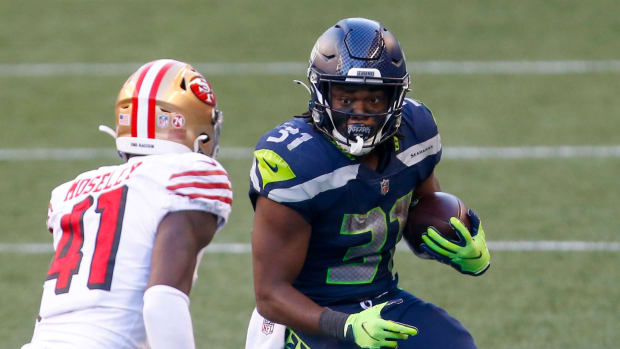Seahawks Offseason Profile: Chris Carson
Following Chris Carson’s impressive first full season in the NFL, let’s revisit how the third-year running back followed up his performance during the 2019 campaign.
Heading into this past season, the Seahawks were planning to utilize the Oklahoma State product significantly more in the passing game. In 2018, the 25-year old running back received just 24 targets and figured to earn a lot more during the 2019 season.
After sustaining lower-body injuries in each of his first two seasons, a broken leg in 2017 and a sore hip in 2018, both Carson and the Seahawks were hopeful he’d remain healthy throughout the majority of this past season. However, No. 32 suffered a broken hip in Week 16 against Arizona and missed the last three games of the year.
Let’s revisit some of the good and the bad from Carson’s third NFL season, along with a prediction of how next season may play out for the star running back.
What Went Right
After producing career highs in touchdowns (nine), rushing yards (1,151) and yards per carry (4.7) in 2018, Seattle was hoping for similar or even better results on the ground from Carson during this past season.
Through his 15 regular season starts, the powerful 5-foot-11 running back produced 1,230 rushing yards (fifth-most among all running backs with at least 150 rushing attempts), seven touchdowns (tied for 13th-most), 4.42 rushing yards/carry (tied for 15th-best), 82 yards/game (sixth-most), 734 yards after contact (fourth-most) and 28 broken tackles (tied for sixth-most), according to Pro-Football-Reference.com.
Along with Carson’s impressive production in the trenches, he was also pleasantly productive as a receiver in Seattle’s aerial attack in 2019.
Among all qualified running backs with 50 receptions or fewer, the former seventh-round selection tied for the fourth-most touchdowns (three) and the 17th most receiving yards (266).
In addition, Carson also generated six broken tackles in the passing game, which was tied for the 27th most among all running backs, wide receivers, and tight ends in the league.
What Went Wrong
For the most part, there isn’t much to complain about Carson’s performance during the 2019 season. But ball security became a major issue for him this past season and it’ll need to be an area that he continuously works on throughout the offseason.
Through the first three games of the regular season, Carson lost hree fumbles, with two of them resulting in touchdowns. These issues soon sparked the conversation about whether the Seahawks would need to start limiting his playing time until these woes were corrected.
Instead of taking that approach, coach Pete Carroll and offensive coordinator Brian Schottenheimer expressed their confidence that the young running back would surge past these issues and he did just that until Week 9.
After making a slight adjustment to how he was carrying the football, Carson didn’t lose another fumble for five straight games. But he then coughed up the ball four times from Week 9 through Week 12.
In total, Carson led all running backs in 2019 with seven fumbles and also tied for the most fumbles lost (10) since the 2018 season. While he didn’t turnover the ball in his final four starts of the season, this will undoubtedly be an area that will be closely observed through next season.
2020 Outlook
Despite recovering from a fractured hip this offseason, the Seahawks are confident that Carson will be ready for Week 1 of next season.
Since 2010, Carson is one of just six running backs who has recorded at least 10 fumbles along with 2,000 rushing yards or more through their first three seasons in the league.
During the following year, only Todd Gurley, Ezekiel Elliott, and Ryan Mathews were able to produce at least 1,250 rushing yards during their fourth season. Interestingly, Alfred Morris and Gurley were the only players in this group to record fewer than two fumbles in their fourth year.
Based on these results, Carson definitely has the potential to produce at least 1,250 rushing yards again if not more in 2020. As the previous data clarifies, ball security issues may be tough to correct moving into the final year of his rookie contract, but other players have made tangible improvements in that area.
If healthy, Carson should receive a similar amount of attention in the passing game next season. However, his overall health will play the biggest factor once again in determining his production during the 2020 campaign and whether or not the team re-signs him.




